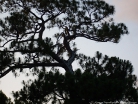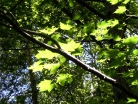
Colorado Fir, Abies concolor (Gord & Glend) Lindl. ex Hildrbr.
Common Names: California White Fir, Rocky Mountain White Fir, Siver Fir, White Fir
State List: AZ, CA, CO, ID, MA, ME,
NM, NV, OR, UT, WY
Visit the Image Gallery for more pictures.
Common Names: California White Fir, Rocky Mountain White Fir, Siver Fir, White Fir
State List: AZ, CA, CO, ID, MA, ME,
NM, NV, OR, UT, WY
Visit the Image Gallery for more pictures.
Sources:
A Natural History of North American Trees, by Donald Culross Peattier © 2007 by Houghton Mifflin Company p. 128
The Wise Garden Encyclopedia- Grosset & Dunlap, Inc., New York, NY ©1970 by Wm. H. Wise & Co., Inc., p. 481
Trees of North America- A guide to field identification-a Golden Field Guide from St. Martin's Press © 2002 By C. Frank Brockman p.30
USDA, NRCS. 2011. The PLANTS Database (<http://plants.usda.gov/>, 22 August 2011). National Plant Data Team, Greensboro, NC 27401-4901 USA.
USDA NRCS, The PLANTS Database Fact Sheet fs_abco(1).docx
Zouhar, Kris 2001. Abies concolor. In: Fire Effects Information System, [Online]. U.S. Department of Agriculture, Forest Service, Rocky Mountain Research Station, Fire Sciences Laboratory (Producer). Available: http://www.fs.fed.us/database/feis/ [2011, August 22].
A Natural History of North American Trees, by Donald Culross Peattier © 2007 by Houghton Mifflin Company p. 128
The Wise Garden Encyclopedia- Grosset & Dunlap, Inc., New York, NY ©1970 by Wm. H. Wise & Co., Inc., p. 481
Trees of North America- A guide to field identification-a Golden Field Guide from St. Martin's Press © 2002 By C. Frank Brockman p.30
USDA, NRCS. 2011. The PLANTS Database (<http://plants.usda.gov/>, 22 August 2011). National Plant Data Team, Greensboro, NC 27401-4901 USA.
USDA NRCS, The PLANTS Database Fact Sheet fs_abco(1).docx
Zouhar, Kris 2001. Abies concolor. In: Fire Effects Information System, [Online]. U.S. Department of Agriculture, Forest Service, Rocky Mountain Research Station, Fire Sciences Laboratory (Producer). Available: http://www.fs.fed.us/database/feis/ [2011, August 22].

Want to add your tree to our picture gallery? Click here for details!
Tree lists:
•A-Z by scientific
name
•A-Z by common
name
•By Family
For state A-Z list click state name below.
•A-Z by scientific
name
•A-Z by common
name
•By Family
For state A-Z list click state name below.
-Color denotes a tree that is rare or endangered

Map courtesty USDA NRCS PLANTS Database


Growing 125-150 feet in height and 2-4 feet in diameter, this native evergreen conifer can live over 300 years. The irregular crown has the typical pyramidal shape expected of fir trees and when grown in most soils, it will retain its dense lower branches. A shallow root system supports a single trunk encased in whorls of branches. The needles of Abies concolor are are deep bluish-green but are the lightest of all nine native firs, with new growth lighter still. Flat and blunt to pointed at the tips, the needles are 2-3 inches long, in ranks of 2, extend at a right angle out from the twig and have silvery bands called stomata running the length of both the top and under surfaces. Oblong and upright, the cones
are yellowish green to purplish brown, 3-5 inches long, and each scale is tipped with a prickle. The seeds are brown and inconspicuous reddish flowers bloom in late spring. When young, Colorado Firs have smooth light gray trunks, which are covered in resinous vesicles, but with age the bark darkens and becomes harder, thicker, and deeply ridged. Although, as a slow growing tree species, the bark is
Rare in Montana and Wyoming

Needles and foliage of Abies concolor
Photo citation: © 1995 Saint Mary's College of California,
Brother Alfred Brousseau
Photo citation: © 1995 Saint Mary's College of California,
Brother Alfred Brousseau
more often a blend between the two stages of development.
Habitat
Colorado fir has the widest native range of all western firs and may be found throughout the western half of United States with isolated populations in Maine and Massachusetts. Abies concolor is typical to drier soils with medium to coarse texture, however, it will retain more of its lower foliage on moist sites. This conifer prefers areas with long humid winters and heavy snowfall and only needs 80 frost free day a year. Although this native tree species is moderately drought tolerant, Colorado Fir requires 18 to 80 inches of rain annually and will attain best growth with rainfall between 35 to 75 inches. Abies concolor tends to grow on mountain slopes but at lower elevations than most others in the Abies genus.
Pests, Disease and Elements
Needle rusts are the most serious disease risk to Colorado Fir, however it is also susceptible to heart rot fungus. Insect pests include bark beetles and spruce budworms and Abies concolor is one of the many hosts for mistletoe. It is also sensitive to sunlight and will scald if suddenly exposed. Care should be taken when pruning to avoid injury. Colorado Fir is also sensitive to sulphur dioxide and is therefore not suited to areas with high levels of air pollution.
Propagation
The small brown seeds require cold stratification and it may be propagated by bareroot, by container,
Habitat
Colorado fir has the widest native range of all western firs and may be found throughout the western half of United States with isolated populations in Maine and Massachusetts. Abies concolor is typical to drier soils with medium to coarse texture, however, it will retain more of its lower foliage on moist sites. This conifer prefers areas with long humid winters and heavy snowfall and only needs 80 frost free day a year. Although this native tree species is moderately drought tolerant, Colorado Fir requires 18 to 80 inches of rain annually and will attain best growth with rainfall between 35 to 75 inches. Abies concolor tends to grow on mountain slopes but at lower elevations than most others in the Abies genus.
Pests, Disease and Elements
Needle rusts are the most serious disease risk to Colorado Fir, however it is also susceptible to heart rot fungus. Insect pests include bark beetles and spruce budworms and Abies concolor is one of the many hosts for mistletoe. It is also sensitive to sunlight and will scald if suddenly exposed. Care should be taken when pruning to avoid injury. Colorado Fir is also sensitive to sulphur dioxide and is therefore not suited to areas with high levels of air pollution.
Propagation
The small brown seeds require cold stratification and it may be propagated by bareroot, by container,
by cuttings or seeds. Cuttings may be grown with or without hormones.
Uses
The fragrant Colorado Fir is probably most familiar as a Christmas tree where it is prized for its superior needle retention after cutting. It is also popular as a landscaping tree, growing well in environments with more shade than other species and is commonly found in nurseries. Additional uses include lumber products, veneer and pulpwood.
Uses
The fragrant Colorado Fir is probably most familiar as a Christmas tree where it is prized for its superior needle retention after cutting. It is also popular as a landscaping tree, growing well in environments with more shade than other species and is commonly found in nurseries. Additional uses include lumber products, veneer and pulpwood.



Thursday, June 05, 2025

|
|
|
|
|
| A-Z scientific | ||
| A-Z by Common Name | ||
| Families | ||
| Browse by State | ||
| Rare or Endangered Species | ||
| Trees_with_Special_Uses | ||
| Tallest and Biggest |
| Aceraceae Maple Family | ||
| Anacardiaceae Sumac Family | ||
| Annonaceae Custard Apple Family | ||
| Aquifoliaceae Holly Family | ||
| Arecaceae, Palm Family | ||
| Betulaceae Birch family | ||
| Bignoniaceae Trumpet Creeper Family | ||
| Burseraceae Frankincense Family | ||
| Caprifoliaceae Honeysuckle Family | ||
| Chrysobalanaceae Coco-plum Family | ||
| Cornaceae Dogwood Family | ||
| Cupressaceae Cypress Family | ||
| Cyrillaceae Cyrilla Family | ||
| Ebenaceae Ebony Family | ||
| Ericaceae Heath Family | ||
| Fabaceae Pea Family | ||
| Fagaceae Beech Family | ||
| Hamamelidaceae Witch Hazel Ffamily | ||
| Hippocastanaceae Horse Chestnut Family | ||
| Juglandaceae Walnut Family | ||
| Lauraceae Laurel Family | ||
| Leitneriaceae Corkwood Family | ||
| Magnoliaceae Magnolia Family | ||
| Meliaceae Mahogany Family | ||
| Moraceae Mulberry Family | ||
| Myricaceae Bayberry Family | ||
| Myrsinaceae Myrsine Family | ||
| Myrtaceae Myrtle Family | ||
| Nyctaginaceae Four Oclock Family | ||
| Olacaceae Olax Family | ||
| Oleaceae Olive Family | ||
| Pinaceae Pine Family | ||
| Platanaceae Plane Tree Family | ||
| Polygonaceae Buckwheat Family | ||
| Rhamnaceae Buckthorn Family | ||
| Rosaceae Rose Family | ||
| Rubiaceae Madder Family | ||
| Rutaceae Rue Family | ||
| Salicaceae Willow Family | ||
| Sapindaceae Soapberry Family | ||
| Sapotaceae Sapodilla Family | ||
| Simaroubaceae Quassia Family | ||
| Styracaceae Storax Family | ||
| Symplocaceae Sweetleaf Family | ||
| Theaceae Tea Family | ||
| Tiliaceae Lindon Family | ||
| Ulmaceae Elm Family | ||
| Taxaceae Yew Family | ||
| Yucca Family |
| Maple A-Z |
| sumac_family_a-z |
| custard_apple_family_a-z |
| holly_trees_a-z |
| palm_family_a-z |
| birch_family_a-z |
| trumpet_creeper_family_a-z |
| honeysuckle_family_a-z |
| dogwood_family_a-z |
| cypress_family_a-z |
| heath_family_a-z |
| pea_family_a-z |
| beech_family_a-z |
| walnut_family_a-z |
| magnolia_family_a-z |
| olive_family_a-z |
| rose_family_a-z |
| willow_family_a-z |
| franklinia |
| elm_family_a-z |
| Federal List | ||
| State Lists | ||
| Invasive_species |
| Restoration of the American Chestnut | ||
| Restoration of the American Elm | ||
| Sustainable Forestry |
| Contact Us | ||
| Our Contributors | ||
| Photo of the Month | ||
| Usage Requirements | ||
| FAQ | ||
| Report a Broken Link |
| photo_submission |
| Photo Store |
™

Custom Search









